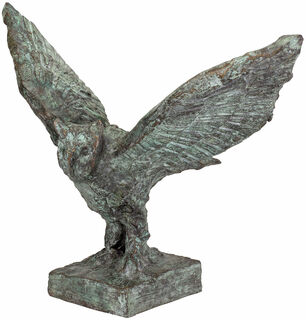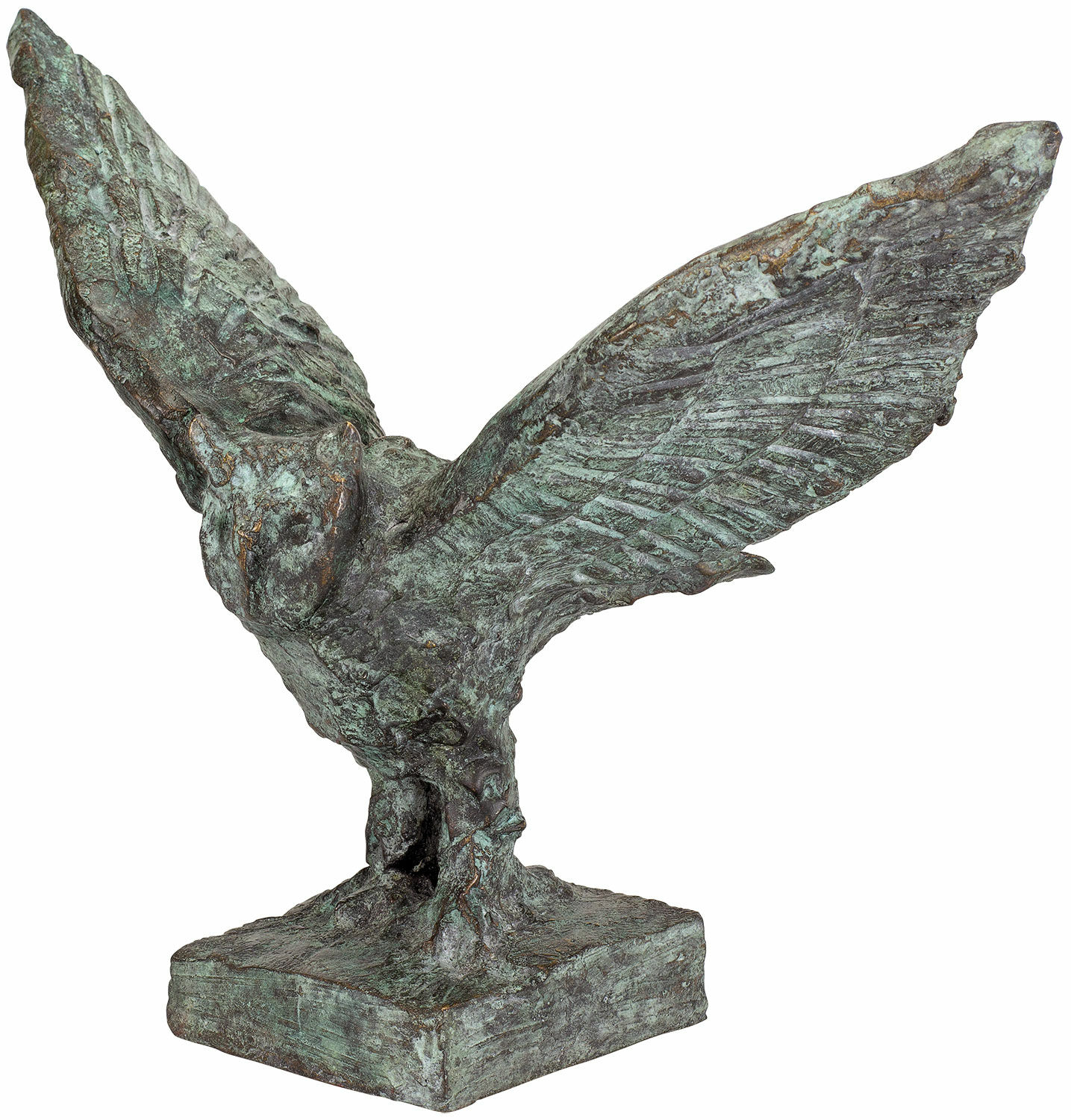Sculpture "Sophia" (2022), bronze version
Sculpture "Sophia" (2022), bronze version
Quick info
ars mundi Exclusive Edition | limited, 49 copies | numbered | signed | hallmarked | certificate | bronze | chased | polished | patinated | size approx. 23 x 36 x 15.5 cm (h/w/d) | weight approx. 3.3 kg
Video
Detailed description
Sculpture "Sophia" (2022), bronze version
Thomas Jastram considers himself a classical sculptor. His sculptural work includes life-size works - among them many for public spaces such as an imposing Neptune Fountain in Warnemünde, which was erected in 2022 - portrait busts and, last but not least small sculptures such as his "Sophia".
The title of his owl sculpture refers to the wisdom attributed to the night bird as the companion of Athena/Minerva since antiquity. Therefore, the owl is a symbol of philosophy. Jastram presents it with its wings spread wide - ready for take-off.
Sculpture in fine bronze, cast using the Lost-Wax-Process, chiselled by hand, polished and patinated. Limited edition of 49 copies, numbered, signed and bearing the foundry and ars mundi hallmarks. With a numbered certificate of authenticity and limitation. Size approx. 23 x 36 x 15.5 cm (h/w/d). Weight approx. 3.3 kg. ars mundi Exclusive Edition.

About Thomas Jastram
Whether portraits, nudes or horses – the German sculptor Thomas Jastram knows how to emphasise the characteristic features of his motifs in his stone, plaster and bronze sculptures. "He always strives to express the resemblance and the charisma of the model in the clay," says his former professor, Helmut Heinze, about him.
Jastram, born in Rostock in 1959, graduated from the Dresden Academy of Fine Arts in 1985, since then he has worked as a freelance artist and had several teaching jobs, including at the Hamburg Technical School of Art.
In addition to various exhibitions, he has created numerous works for public spaces, e.g. a fountain in Ribnitz-Damgarten or the memorial for the victims of Nazi justice in Torgau, Saxony.
An alloy of copper with other metals (especially with tin) used since ancient times.
When casting bronze, the artist usually applies the lost-wax technique which is dating back more than 5000 years. It's the best, but also the most complex method of producing sculptures.
First, the artist forms a model of his sculpture. It is embedded in a liquid silicone rubber mass. Once the material has solidified, the model is cut out. The liquid wax is poured into the negative mould. After cooling down, the wax cast is removed from the mould, provided with sprues and dipped into ceramic mass. The ceramic mass is hardened in a kiln, whereby the wax flows out (lost mould).
Now we finally have the negative form, into which the 1400° C hot molten bronze is poured. After the bronze had cooled down, the ceramic shell is broken off and the sculpture is revealed.
Now the sprues are removed, the surfaces are polished, patinated and numbered by the artist himself or, to his specifications, by a specialist. Thus, each casting becomes an original work.
For lower-quality bronze castings, the sand casting method is often used which, however, does not achieve the results of a more complex lost-wax technique in terms of surface characteristics and quality.
Graphic or sculpture edition that was initiated by ars mundi and is available only at ars mundi or at distribution partners licensed by ars mundi.
Term for an art object (sculpture, installation), which is produced in multiple copies in a limited and numbered edition according to the artist‘s will.
Artist's multiples have been called the most accessible and affordable art on the market.
A plastic work of sculptural art made of wood, stone, ivory, bronze or other metals.
While sculptures from wood, ivory or stone are made directly from the block of material, in bronze casting a working model is prepared at first. Usually, it is made of clay or other easily mouldable materials.
The prime time of sculpture after the Greek and Roman antiquity was the Renaissance. Impressionism gave a new impulse to the sculptural arts. Contemporary artists such as Jorg Immendorf, Andora, and Markus Lupertz also enriched sculptures with outstanding works.






